‘My
Room at the Centre of the Universe’ is the latest release in an innovative
series of educator’s resource books and films produced by the Africa meets
Africa Project AMA.
 |
| Marcus Neustetter (Artist), Big Bang. 2012. |
 |
| Elvirdo with a sparkler-star. Image - Marcus Neustetter, shooting star1-3, 2012. |
FADA Art Gallery, at the University of
Johannesburg’s Bunting road campus, in association with Africa meets Africa, invites
you to the launch on 4 December 2014 at 18h30 for 19h00 of:
My Room at the centre of the
Universe….an evocative resource book and film on DVD for all
those interested in seeking out answers about our place in the universe; and just
how we know what we know:
Join us for an outdoor screening of the story of a bright
sixteen year old who asks the big
questions, as he stares at the brilliant stars in the quiet Karoo night sky through
the lens of his own bedroom window at his Ouma’s
modest Karoo farm house.
 |
| Sutherland, Karoo town, home to SALT. |
On the plateau nearby, just outside the small town
of Sutherland, astrophysicists look at the same stars though the complex eye of
SALT (the Southern African Large Telescope). ‘We are all made of stars, you
know’, Elvirdo’s grandma would tell him.
‘The stars are us…’
‘Stars are the only elemental factories we know of
in the universe. And therefore we can say that every atom we are made of was
made inside a burning star‘, Elvirdo is told by Cosmologist Dr Carolina Ödman
Govender, when he quotes Ouma’s words
to her. Carolina is one of several researchers he comes across when he goes for
walks in the veld near the South
African Astronomical Observatory. Whether these interesting people are
astrophysicists, archaeologists or the occasional visual artist, Elvirdo notices
that they all have one thing in common: they approach the Karoo earth and its sky
with intent and sensitive observation. He asks them his burning questions … and
their answers lead him to more.
 |
| Elvirdo Booysen talking to archaeologist Sven Ouzman in a rock shelter beneath the SA Astronomical Observatory plateau. |
 |
| SKA Dish Sutherland. |
My Room at the Centre of
the Universe
is also the title Elvirdo gives his personal research journal (the book we are
launching on 4 December - image left) now that he has grown up and moved away. He is a
teacher now and started this journal when he was travelling back to Sutherland,
once, to do some professional research.
Since his boyhood years here he has
travelled a great deal and read widely on cutting edge science and contemporary
art, on traditional African cosmologies, on archaeology, geology and poetry
from this arid area. His journal, richly illustrated with photographs,
newspaper clippings and his drawings, is all about his own observation and knowledge
making over many years. He has found many answers and yet more questions.
Mature
reflection has led him to integrating strands of evidence from a range of
disciplines. Yet most often his thinking leads him back to the questions he
posed as a teenager, under these brilliant stars. Maybe one could teach more
effectively by integrating subjects like Science, History, Visual Arts and
language?
He remembers
the conversation he had here with contemporary artist Willem Boshoff, whom he came
across in the veld near SAAO carefully
photographing the smallest details of the most ordinary things. They talked
about really looking. Artists Marcus Neustetter and Bronwyn
Lace helped him make his own artworks, He knew them well from the many artworks
they had made here in Sutherland, drawing his community into a new way of
thinking about their place.
Elvirdo’s room now became a thinking-space for
creative scientific enquiry; almost like the inner space of his own mind:
an idea he would hear the artist William Kentridge talk about, many
years later.
At Carnarvon
Dr Nadeem Oozeer, an Operations and Commissioning scientist at the exciting
international Square Kilometre Array radio astronomy project told him: ‘The
SKA aims to probe the cosmos to the edge of the observable universe’.
Elvirdo’s questions are all about origins,
also his own, through
the ancient KhoeSan ancestry of this landscape. They, he discovers, were
genetically unique, their genome including the oldest distinct lineage of
modern humans!
Ouma knew
many of the old people’s stories.
About the sun cutting away at the moon, and how it would come back to life
again and again. About the stars being the hearts of healers who had died. He
heard about the /Xam San (or Bushmen) who lived around here for centuries as
hunter-gatherers before the Cape Colony’s Trekboers came. He has heard since that
some of the Karretjiemense you see
beside the highway today still carry the DNA of the /Xam and some of our oldest
human ancestors.
There is no limit, it seems, to how far you can see from home, if you
really look.
My Room at the Centre of the Universe (ISBN:
978-0-620-61420-7)
was developed by a team of specialists
in astrophysics, archaeology, geology, paleontology, art history, visual arts,
education and film making. The team includes: Helene Smuts, Bronwyn Lace, Marcus Neustetter,
Guy Spiller, Enrico Olivier, Carolina Ödman Govender, Kevin Govender, Chonat
Getz, Nadeem Oozeer, David Morris, John Parkington, Marcelle Olivier, Bruce
Rubidge, Christine Mullen Kreamer, David Riep, Jackie Scheiber, Willem Boshoff,
Fanie Olivier and Karel Nel. Film directed by Guy Spiller and book lay-out
and design by Anina Bartlett. With acknowledgement of the Sutherland Reflections Project by Lace, Neustetter and the
community of Sutherland.
Published by The Africa meets Africa
Project in June 2014.
About Africa
meets Africa:
This
is the fifth educator’s resource produced by the Africa meets Africa project,
an independent Non Profit Company committed to seeking out pragmatic learning
solutions for the South African classroom, by looking to what is known and
familiar in local southern African knowledge systems. Most often these are preserved
and expressed through the skilled hands of rural artists, who make exquisite
objects (most often for everyday use) according to inherited styles. AmA continually
documents southern African cultural heritage.
The
unique arts skills based Africa meets Africa learning methodology integrates
the arts, history, mathematics and science.
The Theorem of Pythagoras, for example, is found illustrated in an
Ndebele wall painting design (image on the left) and learners do
geometry when they make beadwork according to inherited Zulu styles (image below, left).
Those
learners for whom English is a third or fourth language are supported in the
classroom by an accessible visual language
of learning. My Room at the centre of the
Universe brings new avenues of learning to the project by integrating
science, contemporary art, archaeology and poetry. For sample pages and film
clips see the ‘Publications’ link at www.africameetsafrica.co.za. Each resource book and
film in the series is introduced to teachers along with CAPS curriculum-linked
classroom lesson materials, during workshop programmes presented in partnership
with local universities, provincial or district education departments.
For
additional information on Africa meets Africa please contact:
Helene Smuts, Director of
the Africa meets Africa Project.
Website:
www.africameetsafrica.co.za







%2Bcopy.jpg)













































